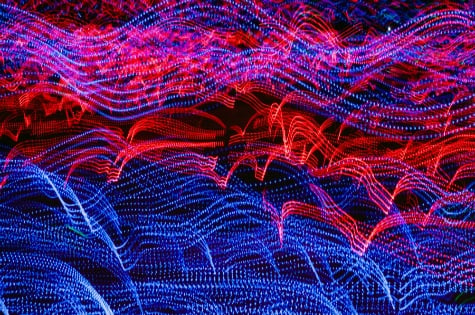
If there's one lighting technology that businesses have a lot of questions about, it's usually LED lights. Light-emitting diodes don't even use bulbs, so they're very new to companies exploring alternative lighting solutions. So let's wrap up our series on lighting technologies by talking about these diodes, and what makes them so powerful.
Science of LEDs
A diode is a very simple type of semiconductor with two terminals, traditionally designed to help switch an electrical current on and off as needed. However, scientists discovered that if they "doped" these semiconductors with just the right combination of elements, the electrical current would make the tiny diode glow. This is called a solid-state reaction, because the diode itself radiates the light naturally – there are no filaments or gases used, and nothing to burn up or consume.
Because the current needed to light the LED is so low, this method of lighting is extremely efficient, and the solid state nature of the diodes means that they can last far longer than a bulb or filament. However, since diodes are very small (only around 1 square millimeter!), LEDs must be clustered together to provide enough lighting for commercial purposes. The colors of LED lights can also shift based on the elements used, which has led to a great deal of experimentation as researchers try to find materials that yield new or more useful colors.
Learn more about the amazing benefits of LED Lighting!
Brief History
LED lights were first invented in the 1960s thanks to a General Electric project. At first their use was limited, and the only color possible was a dull red, unsuitable for businesses or homes. As research continued, yellow and green diodes were created, and in the 1970s LEDs began to appear as basic indicator lights.
The most important discovery came in the late 1980s and 1990s, when scientists learned how to create a blue light diode. With simple coatings, blue light was easy to change to white light, and this processes helped researchers discover much more about how LED lights could be used in every-day applications. Soon LEDs were appearing in control panels, traffic lights, homes and offices.
Things to Consider
-
Life Span
- Average life spans for LED lighting typically ranges from 15,000 to 50,000 hours, which is at least several times longer than a CFL bulb, and around 50 times longer than an incandescent.
-
Energy Usage
-
- When rated by luminous efficiency (lm/W), LED lights range from 70 to 120 lm/W. For comparison, an average CFL (compact fluorescent light) has an efficiency rating of about 73 lm/W. LEDs are widely considered the most efficient lighting option available.
-
Color Options
A roadblock to adopting LED lights for commercial purposes has been their colors – which, while varied, tend to be colder than other lighting options. This has changed in recent years as warmer LEDs have been developed and paired with advanced lens to create a more natural looking light. -
Installations
Compatible LED clusters in bulb-like shapes are sold for lamps, floodlights, and many other purposes. These bulbs can fit into traditional incandescent sockets. -
Quality
We've mentioned life span and efficiency, but it's important to note that these factors depend on the quality of LED production. Poorly manufactured LEDs may quickly fail, which is why it's important to buy from a trusted supplier and dependable manufacturers.
The Future of LED Lights
LED lights have two primary categories: Entertainment and utility. Entertainment LED lights include Christmas lights, lightweight LED ropes, LEDs on toys, LED TVs, etc. This market is stable, but these LEDs are not used for general lighting purposes, and requirements for this sector are generally easier to meet.
Utility LED lights, however, are part of a newer and fast-growing market. In addition to requiring robust, long-lasting LED clusters in colors that mimic traditional lighting options, there's also high demand for LED products that, like CFLs, can be used in traditional lighting sockets – compatible "bulbs" now widely available for retrofitting. However, as LED lights continue to grow in popularity, we will be seeing more buildings designed for unique LED light solutions. Since LED lights can come in so many forms and colors, we can expect a highly creative, progressive industry for many years into the future.
If you missed them, be sure to catch up on parts one and two of our Waves of Lighting Technology series. Want to stay illuminated about LED lighting technologies? Be sure to sign up for weekly blog notificatons at the top of this page!


